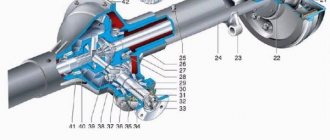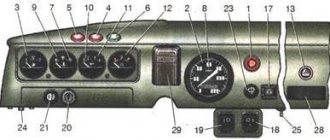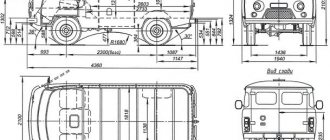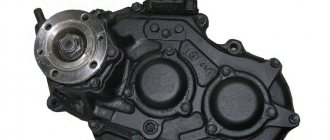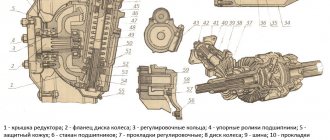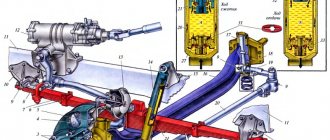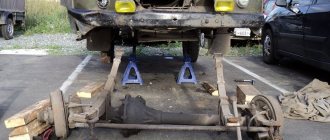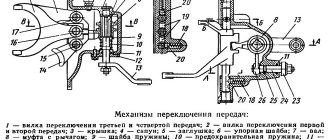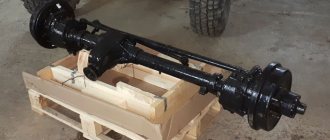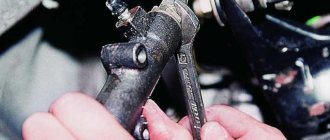Design
The main components of the clutch of the UAZ-452 car:
- driven disk assembly with friction linings;
- a pressure disk or basket assembled with a casing;
- release levers.
The stamped steel casing is attached to the engine flywheel with six centering bolts. It is made with three windows, where the projections of the cast iron pressure plate fit.
Six steel springs are installed between the pressure plate (basket) and the casing.
Their compression force ensures the transmission of torque from the flywheel further through the casing, pressure plate to the driven disc. In order to prevent heat transfer from the springs, washers made of heat-insulating material are installed on the pressure plate side.
Modern cars are equipped with a hydraulic drive instead of a mechanical drive . The fluid creates increased pressure, making it much easier for the driver to control the pedal.
Site about SUVs UAZ, GAZ, SUV, CUV, crossovers, all-terrain vehicles
On UAZ cars with a UMZ-421 engine, a diaphragm clutch with a driven disk diameter of 240 mm was predominantly installed, although in some rare cases a lever-type clutch with a driven disk diameter of 254 mm could be installed.
The UAZ diaphragm clutch with the UMZ-421 engine had a drive disc with catalog number 4173.1601090, and for cars of the GAZelle family with the same engine - catalog number 406.1601090. The specified drive discs differ only in the shape of the diaphragm spring petals and the thickness of the pressure plate. The driven clutch disc for UAZ and GAZelle was single, until 2001 with catalog number 4173.1601130, and later - 421.1601130.
Due to the fact that disk 406.1601090 has a greater pressure disk thickness than disk 4173.1601090, when installing it on the UMZ-421 engine with driven disk 4173.1601130, three sickle-shaped steel plates 4215.1601080 1 mm thick were installed between the drive disk casing and the flywheel plane.
UAZ diaphragm clutch with UMZ-421 engine, general structure and principle of operation.
The UAZ diaphragm clutch is single-disk, dry, and permanently closed. Installed in the same clutch housing as the lever type clutch. The location of the holes on the flywheel for its fastening is shown in the figure below. A washer with an outer diameter of 21 mm, an inner diameter of 10.5 mm, and a thickness of 4 mm was installed under the ball joint of the clutch release fork.
The crankshaft, flywheel and clutch assembly were jointly balanced at the factory. After balancing, “O” marks were applied to the flywheel and clutch housing by impact. The UAZ diaphragm clutch with the UMZ-421 engine consists of two main units - the drive disk and the driven disk.
The drive disk of the UAZ diaphragm clutch with the UMZ-421 engine.
The drive disk consists of a casing, support rings, a diaphragm spring, a pressure plate and connecting plates. The clutch housing is secured to the engine crankshaft flywheel with six centering bolts. The force of the pressure diaphragm spring creates the necessary friction force on the surfaces of the friction linings and ensures the transmission of torque from the flywheel through the pressure disk, casing and connecting plates to the driven disk and the input shaft of the gearbox.
Clutch functions
By pressing the pedal, the driver acts on the fluid in the line. The fluid transfers pressure from the master cylinder piston to the slave cylinder piston. The working cylinder moves the shutdown fork with its rod.
Together with it, the release bearing is pressed, transmitting force to the clutch mechanism, which disconnects the transmission from the power unit.
By releasing the pedal, the driver returns the entire mechanism to its original state. Under the influence of the return springs, all parts involved in the process of squeezing the clutch take their normal position.
What's the result?
As you can see, during the operation of the car the clutch fork is subject to wear. Although a high-quality part lasts quite a long time, by 100 thousand km the fork may fail. Even if during the inspection it was not possible to find cracks or other defects, there is a high probability of wear of the paws. In any case, the part requires replacement.
Finally, we note that quite often, along with the clutch fork, the clutch will also require replacement. The area where the fork contacts the surface is also where wear occurs. For this reason, you should make sure in advance that it is advisable to solve the clutch problem only by replacing one fork. Otherwise, you will need to re-disassemble the clutch mechanism, install a release bearing, etc.
The clutch pedal is tight, the clutch is pressed hard: the main causes of the malfunction. Diagnosis of clutch problems and repair. Tips and tricks.
The clutch pedal has fallen: why does this happen? The main reasons why the clutch pedal fails, what should the driver do if the clutch fails.
Types of clutch drive. If the clutch pedal falls, the clutch has become soft, problems have arisen with the clutch: causes and repair of major faults.
How to adjust the clutch pedal, what adjustment is needed for: clutch functions, clutch pedal adjustment (free play and total travel).
Car clutch: purpose, types, design, principle of operation. Frequent clutch malfunctions in the vehicle transmission system, signs of problems.
Car clutch and design overview: clutch pressure plate, driven disc, release bearing. Types of clutch drives on manual transmissions and manual transmissions.
Source
Carrying out replacement
Step-by-step replacement instructions:
- Place the UAZ loaf car on high supports made of bricks and wooden blocks. Avoid falling from supports.
- Drain the operating oil from the gearbox and gearbox.
- Unscrew the rear driveshaft from the drive shaft. Place tags. When reassembling, install exactly the same as it was. Otherwise vibrations will appear.
- For the convenience of further work, unscrew the rear cardan completely - from the rear axle too. Place tags. Unscrew the front driveshaft only from the drive shaft. Place tags.
- Remove the muffler.
In this case, disconnect one by one:
- clamp from the exhaust pipe bracket;
- muffler clamp;
- bolts connecting the muffler and catalyst flanges;
- resonator clamp.
- Remove the entire muffler structure from its original location. Place it to the rear of the car. Place all the bolts and nuts in their places so that nothing gets lost.
- Remove the thermal shield.
- Unpin the gearbox control lever rods. To avoid subsequent adjustments, do not touch the adjusting nuts on the rods.
- Undo the handbrake cable. Move to the side together with the cable protective cover.
- Remove the reversing signal wire block from the sensor block on the gearbox.
- Disconnect the speed sensor wire from the sensor.
- Remove the clutch slave cylinder.
- Disconnect the control rods of the control levers.
- Remove the two oxygen sensor wires in front and after the catalyst from the connectors.
- Disconnect the exhaust pipe from the engine.
- Disconnect the catalyst and bracket from the clutch housing.
- Raise the engine slightly with a jack using bricks.
- Unscrew the four nuts securing the gearbox to the crankcase.
- Loosen the eight bolts on the two brackets securing the gearbox to the frame. During removal, nothing should cling to the gearbox.
- Place convenient stands under the gearbox: old tires, pallets and completely unscrew the bolts holding it.
- Using a pry bar, move the gearbox assembly with the control gear back, allowing its entire mass to lean back onto the stands. Together with the stands, we pull the gearbox out from under the car. The gearbox with clutch and transfer case has been removed. Let's start replacing the clutch.
A little about the history of the creation of the Soviet SUV
Initially, the UAZ 469 was developed as an all-terrain military vehicle, which was intended to replace the older GAZ -69 model. The car was developed from the mid-60s, and began to be mass-produced in 1972; its further modification was the UAZ-3151 (produced since 1985). The civilian modernized version was the UAZ-315195 Hunter. Three years ago, the Russian Ministry of Defense completely refused to supply UAZ, switching to other types of SUVs. Although UAZs have proven themselves in the army as reliable, unpretentious vehicles, they are very outdated.
The familiar Loaf model
The UAZ 3303 commercial truck became a further modification of the famous “loaf”, a family of cars from the Ulyanovsk plant, including the very first UAZ 450. It began to be mass-produced back in 1958. The car became the first independent development of the plant, based on the components and assemblies of the GAZ-69 and GAZ-21. The very first tests exceeded all the designers' wildest plans; the car confidently overcame even snow cover 50 cm deep, and also drove along a tank track with a load of a ton of weight. The development of the SUV began in the mid-50s, prototypes appeared a month later.
Since the GAZ 69 had an unsuccessful wheelbase, the new car had to use a carriage layout, which was developed in two modifications:
- a truck with a wooden body;
- all-metal van.
To ensure the necessary rigidity of the body, ribs were developed on the roof of the van, which visually resembled a loaf of bread. In the mid-late 80s, the “loaf” underwent modernization, the engine remained old, but boosted to 90 horses. The SUVs were equipped with an improved dual-circuit braking system and a vacuum clutch release amplifier, and the bridges were also modernized. The names have changed once again.
A UAZ-3303 light-duty flatbed truck, a UAZ-3741 multi-purpose van, a UAZ-2206 minibus, and a UAZ-3962 ambulance appeared. Ten years later, the plant began experiments to improve the characteristics and improve the “loaf”; a variety of cars were produced, in particular, the “Farmer” family, but in the early 2000s the management changed, all new projects were canceled, and since then they have been producing one van modification.
The principle of operation of the clutch on the UAZ loaf
By pressing the pedal, the driver acts on the fluid in the line. The fluid transfers pressure from the master cylinder piston to the slave cylinder piston. The master cylinder moves the fork piston.
The release fork presses against the release bearing, which transmits force to the clutch mechanism, which disengages the transmission from the transmission.
By releasing the pedal, the driver returns the entire mechanism to its original state. Under the action of the return spring, all elements involved in the process of disengaging the clutch assume their normal positions, this is how the UAZ loaf clutch works
Operation of the GVC
Below is a brief description of how the clutch works:
- When you press the clutch pedal, the pusher moves the piston and the compensation hole closes.
- It pushes fluid in front of it into the system, creating pressure.
- This pressure acts on the piston of the working cylinder, which pushes the rocker arm through the rod.
- The fork, moving the release bearing, acts on the crankcase petals, releasing the pressure plate from the clutch disc.
The valve and disc play an important role in the pumping process. Even if the system is not primed, it will still fill up. Simply unscrew the master cylinder valve and allow the fluid to flow through it. It fills the system by gravity, the same applies to the brakes.
The liquid enters through the expansion port into the cavity in front of the piston through the valve into the line. When filling is complete, the liquid flows out through the valve. The most important thing is that the piston rod should not be extended, and the expansion hole should not be blocked by the handle.
When pumping, everything happens a little differently.
- When the piston moves forward, valve 19 is open.
- When moving backwards, the valve is closed and the front valve creates a vacuum.
- There are holes in the piston that are closed by plate 3. It retracts and opens the holes. Liquid flows from the space above the piston and reservoir through the bypass hole into the space in front of the piston, which is under pressure. The collar (cork) allows it to overflow.
- When the lock ring is reached, the piston stops and the spring compresses the plunger and plate. It's ready for a new cycle.
Clutch design of the most common UAZ models
The entire clutch system UAZ loaf
First, let's define the term "clutch". It is necessary for smooth connection and disconnection of the crankshaft with the vehicle transmission. This is necessary when changing the driving mode (changing gears in the transmission) or stopping the car. The UAZ 469 military jeep was equipped with a dry single-plate clutch, a very popular system in the automotive world at that time. This coupling consisted of the following components:
- pressure disk in the housing;
- special pressure springs and clutch release levers;
- friction disc equipped with friction linings.
The general design looks like this. The so-called casing (clutch housing with all mechanisms) is bolted to the crankshaft. Alignment is established according to the factory marks on the housings. It is important to understand that when the driven and driven plates touch, a tremendous amount of friction is created to transfer torque from the crankshaft to the vehicle's transmission, which transfers it to the wheels.
Removing air from the drive hydraulic system
Quite rarely, but it happens that the clutch needs bleeding. This can be understood from the fact that it does not turn off completely and the pedal is not pressed so softly. Bleeding is the removal of air from the hydraulic system. This process is carried out when the liquid in the tank is at a normal level.
During work, it is necessary to remove the rubber cap located on the bypass valve and install a hose in this place. Then the other end of the hose is lowered into a 0.5 liter container containing brake fluid in a ratio of 1:3.
Afterwards, the bypass valve must be turned one turn while another person presses the pedal all the way. You need to press the pedal until the air bubbles stop being released. The bypass valve must then be tightly closed.
Some UAZ owners may recommend tightening the bypass valve after each pedal press. This will help to significantly increase the pumping speed and achieve complete neutralization of air. Usually the air disappears from the system after the third or fourth repetition of the operation.
UAZ cars are very reliable. It doesn't take much effort to fix clutch related problems. You can carry out all the work yourself or contact a technical service. Clutch repair or adjustment is not an expensive service. As the owner of one of the UAZ series of cars, you need to carry out timely and constant care of the car, since an unscrupulous attitude can lead to severe pollution and lead to a number of difficult-to-solve problems.
Clutch malfunction UAZ loaf
The main malfunction of the GTZ is damaged flanges. If the “mushroom” is faulty, the piston will not create pressure in the system, and the UAZ loaf clutch will stop compressing. It usually has nicks, cracks, or is simply worn out. Frequent, repeated clicks will, of course, help, but not for long. You can't rush and get stuck. You need to replace the cuff or replace the main cuff entirely.
In the second option, if the second ring is damaged, the liquid will leak out. DOT will drip onto the cabin floor. It is quite possible to replace the ring from the repair kit.
Frequent malfunctions and their causes
The clutch system of a UAZ car is characterized by various violations: the reinforced clutch of the UAZ is a loaf, the mechanism does not squeeze out, slips or does not pump. Timely maintenance, replacement of worn parts, lubrication and monitoring of the fluid level in the tank, diagnostics of all systems and mechanism components allows you to avoid such problems.
Disadvantages and criticism of cars from the Ulyanovsk plant
Real photo inside the car
Initially, very high fuel consumption, as well as low passive safety: an accident involving a UAZ usually ends tragically. At the time of development, these shortcomings were compensated by the affordable price of gasoline and low traffic volume, which reduced the likelihood of an accident or accident to a minimum, but over time the situation changed, and today the old designs have become morally and technically very outdated, not corresponding to new realities.
Older models from earlier releases have a gearbox without synchronizers, an unreliable braking system and problems with the clutch. High fuel consumption in modern times forces owners to either buy newer models equipped with economical injectors or turbodiesels, or convert existing old cars.
Most owners, especially those with low incomes, do not try to re-equip the car; they have one pressing problem: the clutch.
With standard equipment and market quality components, replacement occurs after 5-7 thousand km when driving on normal roads. And when a UAZ is equipped with self-locking differentials or gearboxes, especially off-road, the clutch simply cannot stand it.
Clutch repair UAZ loaf
Having a diagram of the internal structure allows you to carry out repairs yourself in case of simple defects. Increased fuel and oil consumption, coolant leakage, unusual noises and knocking in the mechanism are the first signs of the need for repairs. Maintenance and replacement of worn parts help extend the life of parts and vehicles.
How to adjust the clutch pads
To adjust the UAZ loaf clutch, the following repair work must be performed:
- Using a ruler, measure the free radius of movement of the drive pedal that disables the mechanism. The standard value for the spring type should be in the range from 35 to 55 mm, for the membrane type - from 5 to 30 mm.
- Measuring the full travel of the pedal when it is lowered all the way. The standard value for the lever-spring type is 18.5 cm, for the membrane type - 16.5 cm.
- Set the desired position by changing it using the key.
- Check the distance with the pedal down between the engine block bulkhead and the center of the rod shaft. The value of 9.6 cm must be achieved. The fork free play must be at least 1.7 cm. Changing the length of the work basket bias rod is an adjustment tool. To do this, remove and reinsert the pusher until the desired value is reached.
Replacing the clutch of a UAZ loaf with your own hands
First, drain any remaining fluid in the system. This can be done using a syringe. This operation is necessary in order to flush the hydraulic cylinder system from contaminants. On some models, access may be limited by the cooling system expansion tank. For convenience, loosen the nuts holding the tank and remove the hose. It should be unscrewed with a 10 mm wrench. Next, remove the metal tube coming from the clutch master cylinder. It could be copper or aluminum. Then remove the master cylinder by unscrewing the two mounting nuts with a 13mm wrench. You must use a 17mm socket to remove the hose coming out of the slave cylinder. Then we will need a 13mm wrench again.
Use it to unscrew the two bolts securing the clutch cylinder. The UAZ is in neutral gear at this time. The working cylinder itself in this car is installed on the gearbox housing. Carefully remove the pushrod from the fork to avoid damaging other components. If the hoses are removed “on the fly”. (i.e. with the component removed), the cylinder can be secured on one side with an adjustable wrench, and the tube can be unscrewed on the other side using a spanner. However, be careful, as the rubber may break under mechanical stress.
Need for adjustment
Adjusting the pitch of the cone in the clutch cylinder is done to ensure that the clutch performs its task correctly. If configured incorrectly, two types of interference may occur.
